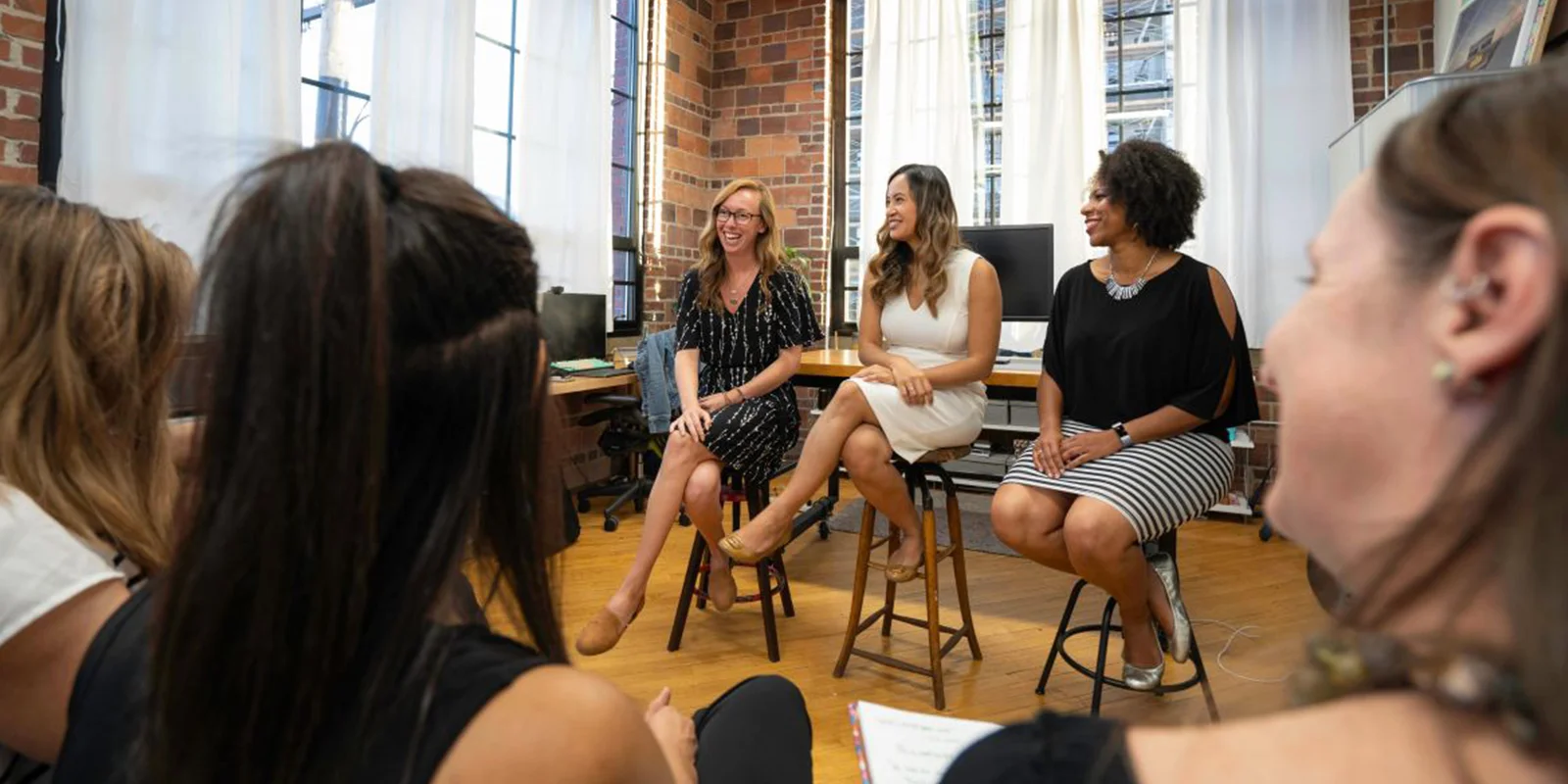
10 Gender Traps in Communications—And How to Escape Them
When it comes to building a more representative, just, and equitable society, it matters who gets quoted, heard, promoted, and elected—not just in a designated history month but year-round.
In our work to diversify the voices and experts who appear in the media, we refer to this as “voiceshare.” And when it comes to voiceshare, our research and media analysis reveal a significant and pervasive gender disparity across all ethnicities and across most of the issues we address. This disparity shows up in the authorship of op-ed placements, in the spokespeople chosen for broadcast interviews, and in the composition of expert panels.
And if breaking into news coverage and achieving equality in our voiceshare wasn’t hard enough, the societal norms we have been raised under further undermine our efforts as women to speak up. They encourage us instead to soften our approach to be more likable. To tone our messages down so that we don’t come off as angry. And they convince us, in myriad subtle and not so subtle ways, that we are not qualified to speak on the subject at hand (whatever it is).
Just how powerful and pervasive are these gendered social norms? In one of our recent week-long media and spokesperson training for mid-career women, we asked each of the 20-plus participants to list her top challenges and fears in developing her skills as an expert and spokesperson. Impost(her) syndrome was at the top of the list for most participants, regardless of their impressive credentials.
In this post, we want to pull back the curtain to reveal 10 of the most prominent gendered communications traps that we and those we train struggle with. In this case, I am using “trap” as a euphemism for being lulled into a societal norm or gendered pattern of communications, which feels safe, but which fundamentally diminishes our voice and expertise, undermining our credibility no matter what the subject.
We aim to provide some fool-proof strategies to avoid and escape them—one communications trap at a time.
1. Speak up.
Scientific studies have debunked the stereotype that women talk more than men—when, on average, they talk the same amount, at about 16,000 words a day. However, this is not the case in meetings and classrooms across the country, where men speak nearly three times as much as women. Let’s change that.
- Speak at least once, inserting yourself in the discussion, and don’t hold back in being yourself when you speak.
- “Step up, Step back.” Be mindful of how much you are speaking and recalibrate accordingly. Speak more if you don’t speak enough, less if you speak too much, and actively encourage other women to speak.
- Increase the gender diversity of your staff, board, or classroom. One study examined how speech patterns change as more women join decision-making boards. They found that women did not speak for an equal amount of time until they comprised 80 percent of the board.
- And when you do speak up…
2. Put your opinions out there; don’t qualify them.
How many times have you started or ended your points with comments or qualifiers like these?
- “Would you mind if I…”
- “I’m no expert, but…”
- “Does that make sense?”
- “I could be wrong, but…”
- “Please push back if you disagree, but…”
- I’m sure you know better than I, but…”
- “I’m not sure, but…”
As women, society has taught us to cushion our statements politely, and we are often amenable to doing so in case (or for fear of) being wrong. Why? Because stepping up with our opinion or advice is taking a risk. Still, we know for a fact that the more perspectives, experiences, and ideas we bring (and invite) to a discussion or problem, the better equipped we are to come to a better solution—a solution that reflects the broadest diversity of choices and perspectives. These qualifiers devalue our views and experiences and implicitly diminish the weight and trust others assign to them.
You are entitled to your opinion. Your perspective and experience matter. Sometimes people will agree with you. Other times they won’t. A diversity of views is a good thing.
Put your opinions out there. Don’t qualify them.
3. There is a time and place for being polite.
Have you caught yourself or a colleague using any (or all) of the following?
- “Um…”
- “Like”
- “So…”
- “Er…”
- “You know”
- “I feel like…”
- “Kind of”
In linguistics, these are called “discourse markers” (“you know,” “so”) or filler pauses (“um,” “er”). Their social or interactional purpose is to be polite. These markers are often an essential part of effective communications. For example, when someone invites you to lunch, instead of bluntly saying no, you politely say, “Um, well, I’m so sorry, but I have another commitment that day.”
These fillers are also critical in speech, as compared to the written word, in making our language more conversational and accessible to others.
However, they are not helpful when someone asks you to share your opinion, experience, or expertise on a subject, such as in an interview or on an expert panel. Overusing fillers in these instances communicates to your audience that you are unsure of what you are saying, diminishing the power of your words, thoughts, and ideas.
Because these fillers are often unconscious and are much more prevalent in our speech, it usually takes either a friend, a blunt critic (they have their place), or listening to a recording of ourselves to recognize how we are using them.
In addressing these fillers, your goal is not to eliminate them. The goal is to be conscious of how often you use them, when they undermine your expertise, and when they aren’t necessary.
4. Reassess your apology strategies.
- “I’m sorry, but…
- “I’m sorry, but can I just say that I think the first proposal was better than the second? I could be totally wrong; I have no idea. Just throwing it out there.”
- “Sorry, could you send me that report I asked for?”
Women’s tendency to qualify and apologize unnecessarily is what columnist Alexandra Petri called the “Woman in a Meeting” language. In a different column, author Nian Hu writes, “While men are able to deliver their opinions and ask their questions in a blunt and straightforward manner, women to often equivocate, apologize, and frame everything they say in vague language.”
Having the self-awareness and humility to apologize and admit when we are wrong is a strength and an invaluable leadership trait. However, many of us have been socialized from a very young age to over-apologize, undermining our credibility and authority.
Here are some tips and tricks for not over-apologizing:
- Keep an apology log for a week. Jot down how many times you apologize in a given day and what for. Pay particular attention to how it comes up in your conversations and meetings.
- Get the Just Not Sorry – Gmail Plug-in, which alerts you—underlined in red—every time you use the word “Just” or “Sorry” in an email, allowing you to be more conscious of how often you are using these in your communications and to reconsider before hitting send.
- Don’t apologize for things that are out of your control.
- Remove “sorry” altogether. For example, in the phrase above, switch sorry out with, “Could you please send me that report?” Or instead of saying “Sorry, I was late,” say, “Thank you for waiting for me.”
- Replace “sorry” with “Unfortunately” or “Excuse me.”
5. Stop interruption in its tracks.
“Oh, I’m sorry, did the middle of my sentence interrupt the beginning of yours?” How good would it feel actually to say that out loud? But… that’s not what we are recommending.
In Madeline Albright’s words, “the combination of being raised to be polite, listen to other people’s ideas, and then this kind of lack of security, ‘Is this something I’m competent to discuss?’ … We question ourselves much more than men,” she said. “‘Shouldn’t I just wait and not talk initially?’ But if you raise your hand, and you don’t get called on, by the time you do, what you had to say doesn’t make sense anymore. It’s not germane. So I made up this term, active listening—you listen differently if you think you’re going to interrupt.”
Numerous studies show that women are interrupted nearly twice as much as men—by both men and women—and even more for women of color. In one study of male-female pairs, researchers found 48 total interruptions—with men instigating 46 of the 48.
Everyone has different comfort levels with interrupting others or how passive or assertive they are in addressing being interrupted. And we all have a role to play in limiting interruption—you, men, and our institutions.
Here are some things you can try when you are being interrupted:
- Say, “…hold on one second, let me finish,” or “I have two more points to make, and then I will take your question.”
- Say, ”I see Steve has something to add,” or “I am eager to hear your feedback, Steve—after I finish.”
- Say, ”
Can youplease stop interrupting me.” - Speak in shorter sentences, physically lean in when you are speaking, maintain eye contact, and use firmer language—”will” instead of “might,” ”know” instead of “believe.”
- Keep talking (ignore it).
Here are some things men should do:
- Pause. Ask yourself why you are interrupting. Are you seeking clarity? If so, then make sure you give the floor back to the speaker when you are done. Are you trying to help yourself remember something? Then take notes instead.
- Don’t keep your hand raised (or unmute yourself) while someone is talking. Write down your question. Drop your hand as soon as it is acknowledged or the other person starts to speak.
- Practice bystander intervention. Don’t stay silent. Speak up and help stop an interrupter. Say, “Wait, let her finish,” or “Hey, I want to hear what Sarah was saying,” or “I don’t think Julie had a chance to finish her point.”
Here are some things your institution can do:
- Institute a no interruption policy and teach facilitators and senior staff to enforce rules that maximize listening, minimize interruption, and effectively address interruption.
- Suggest facilitation protocols that limit interruption, such as having go-arounds and giving each participant two minutes to speak without interruption.
6. Learn when and how to say no.
Research shows that we expect women to say “yes” and agree to requests more frequently than men. At the same time, women have a tougher time saying no. And when they do say no, many women feel guilty or worry about being perceived as terse. In general, saying yes can be a good thing, but saying no can be just as important. This includes saying no to a speaking engagement that does not center your expertise or further your career or saying no when you tend to overcommit.
Learn to say no:
- Make the call: Decide what panels and interviews you do and do not want to be on and why? What helps you reach your strategic goals? What do you get out of it?
- Don’t bury the lede: When asked to do something, include the words “YES” or ”NO” in the first sentence of any response. You can still provide the context in the second sentence.
- Suggest an alternative: Is there another expert who could substitute for you? Then, CC the appropriate person: “…that is a question for Thomas…who I have cc’d here.”
- Replace “can’t” with “don’t.” One research study found that saying “I don’t” instead of “I can’t” allowed participants to extract themselves from unwanted commitments more easily. “While ‘I can’t’ sounds like an excuse that is up for debate,” the study found, “‘I don’t’ implies that you’ve established rules for yourself, suggesting conviction and stability.”
Practice:
Can you think of a time in the last year when you said “yes” to something when you wanted to say “no”? How might you respond if a similar situation presented itself again? Could you say no to it? How could you provide context about your decision but be firm about it?
7. Get credit where credit is due.
This one hurts women from both sides: Many women are uncomfortable taking credit (or accepting praise) for their work, downplaying their efforts, or attributing them to “luck.” At the same time, women, particularly in academia, face the challenge of other people taking credit for their work without attribution or confront deep-seated social biases in the workplace that result in them getting less or no credit for their ideas. In a lab study of adults working in teams, researchers found that women who speak up with ideas are far less likely than their male counterparts to gain the respect of the team and to be seen as a leader. Further, “men are given more credit than women even when saying the exact same thing.”
In addition to learning to be more comfortable with taking and getting credit (see a few more tips below), the most important way of combating these unconscious biases against women in the workplace is for each individual to step up and ensure that they give credit where credit is due. The author of the study poses a challenge to every man reading it, “to go into your next meeting and see who comes up with ideas and who gets credit for them,” Emich said. “I know this was an eye-opening exercise for me—being a man who was previously unaware of the level of bias women face. At first, just observe,” he said. “Then, eventually, step up and give credit where credit is due.”
Learn to take back credit:
Find a way to join your credit-stealer in celebrating the work—but then make it clear that it was your idea or work. For instance:
- “I am glad to hear that you read my paper, Willard…”
- “It’s wonderful you are so excited about my findings, Roland.”
- “I remember talking about this with you when I was writing the paper, Lucy” or “when I researched it…”
Build your “who’s-got-your-back” team:
Women working in the Obama White House used a strategy they called “amplification” to ensure their voices were heard in meetings full of men. “When a woman made a key point, other women would repeat it, giving credit to its author,” wrote The Washington Post’s Juliet Eilperin. “This forced the men in the room to recognize the contribution — and denied them the chance to claim the idea as their own.” Not only did this strategy work for them, it then went viral, with women across the government (and across the country) sharing how much it has helped them.
8. Slay your Impost-her syndrome
Imposter syndrome, self-doubt, and feeling like a fraud are common amongst women, especially in the workplace. Do I really belong there? Are people going to see right through me? Would someone else be better for this opportunity? These are all questions women frequently ask themselves.
But you aren’t alone.
The question is, what can you do about it?
- Luck vs. skill: You aren’t lucky to have had this opportunity; you worked for it. Don’t cast off praise (noted above) by framing it as luck. You earned it. Accept it, acknowledge it, and move on.
- Fake it ‘til you make it: Don’t feel qualified to be in a particular position, on a panel, or speaking to a reporter? Take a chance. Prepare, practice, and put your best foot forward. You can’t get more experience without, well, getting more experience.
- Feeling like a “token”: Wondering if you were invited for an opportunity simply because they needed a woman represented? Or someone of your ethnicity or background—but not specifically you? It’s possible. Ask yourself a few questions: Can you make this opportunity advance your own goals and needs? Will it help you build your professional profile? Does it help get you out there or introduce your work to a new audience? If yes, then make it work for you.
- Truly feeling unprepared: Do you genuinely feel unprepared for this opportunity, or is everyone else on the panel much more senior in their roles than you? Consider if you think you can hold your own. If you do not genuinely feel ready, decline. It is better to politely turn down an opportunity than to flounder and look like an amateur.
How to overcome your inner impost-her:
- Name it: Give it (him) an annoying name (Think, “There goes my Chuck again,” and interrupt him).
- Take the Boasting Challenge*: Women often find it difficult to highlight their accomplishments and often fear being perceived as braggy if they do. So, practice: Take two minutes to list your five greatest achievements, your strengths, or areas of your expertise. Have a friend do the same. Then have your friend boast about you, and you brag about her. Make this a regular exercise.
- Own your expertise: Hone your elevator pitch and memorize it. This is a reliable way to consistently convey who you are, what you work on, and why it matters. Feel confident by preparing answers to commonly asked questions that can reaffirm your expertise.
- Don’t think it’s just you: It’s not.
- Stop beating yourself up.
- Do this with every woman on your staff: Hear someone’s imposter syndrome coming out? Help her address it, build her up, and encourage her to take the opportunity in front of her.
*Adapted from Feminist Fight Club—an excellent read.
9. Feeling small? Take up more space.
As Carol Kinsey Goman, PhD, described, “Men expand into physical space, while women tend to condense their bodies—keeping their elbows to their sides, tightly crossing their legs, stacking their materials in small, neat piles, and contracting their bodies to take up as little space as possible. Men’s expansive posture not only looks more confident, it helps create the corresponding feeling of confidence. By contrast, when a woman’s posture makes her look smaller, it also makes her feel less powerful.”
By physically taking up more space, we can help ourselves feel and project confidence. Your body changes your mind, your mind changes your behavior, and your behavior changes outcomes.
Here are some ways to do that**:
- Sit in your power on panels: Perch on the edge of your chair with your feet planted solidly on the floor. Whether you are feeling confident or not, your body language will project confidence.
- Use your body language: Sit or stand up straight, lean forward, and use hand or arm gestures (think tadasana or “mountain pose” in yoga).
- Move forward: Don’t hang towards the back; sit next to the speaker.
- Speak up: Speak at least once, inserting yourself in the discussion, and don’t hold back in being yourself when you speak.
** Adapted from “How I Claim Physical Space as a Woman of Color”
10. Be aware of your own unconscious biases and correct for them.
You’ll remember from Tip 5 on Stopping Interruption In Its Tracks that women are interrupted twice as much by both men and women. As colleagues and allies, it is incumbent on us to understand that we all have unconscious biases—ingrained prejudices that we may not even be aware of. And that it is not only men that reinforce some of these gender traps, but women too. The more we are aware of and continually challenging our prejudices, the better equipped we are to escape a trap of our own making.
Exercise:
Take a few minutes to jot down which of the 10 gendered communications traps you want to work to address over the next few months—and recruit a friend to help you hold yourself to those goals.



